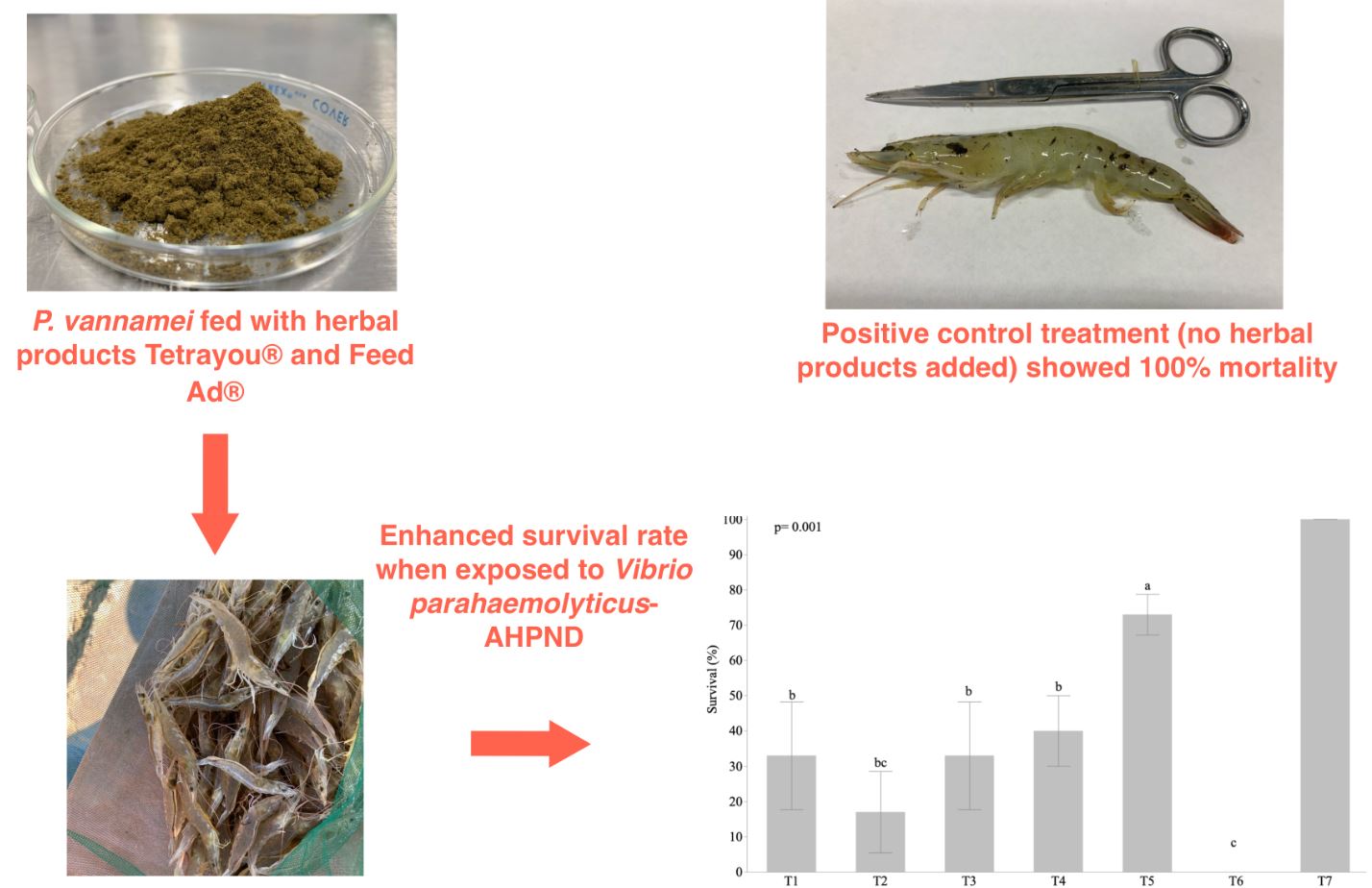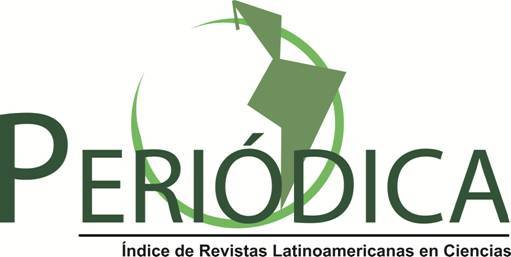Effect of commercial herbal-extract products Tetrayou® and Feed Ad® on the survival of white shrimp, Penaeus vannamei challenged with pathogenic Vibrio parahaemolyticus-AHPND strain
DOI:
https://doi.org/10.18633/biotecnia.v27.2518Keywords:
AHPND, Compuestos herbales, Ecológicamente amigables, Vibrio parahaemolyticusAbstract
Acute hepatopancreatic necrosis disease (AHPND) is the most critical shrimp disease due to the economic losses registered worldwide. Herbal remedy is one of the most important eco-friendly strategies due to its content of natural bioactive compounds than can act against bacterial diseases. In the present study, organisms of P. vannamei were challenged with a strain of V. parahaemolyticus-AHPND. A simple experimental design was performed to compare the survival rate among five different commercial herbal extracts concentrations of Tetrayou® and Feed Ad® against a control treatment. Gross observation and histopathology were carried out on moribund organisms. Significant differences were observed (p<0.05) where organisms fed with T5 (400 mg Tetrayou®/Kg of commercial feed + 1g Feed Ad®/Kg of commercial feed), showed the highest survival value (73 ± 5.8%) in comparison to the rest of experimental treatments. Gross observation showed the characteristic signs of AHPND which were supported by histopathological analysis. It was concluded that Tetrayou® and Feed Ad® are suitable products to enhance the survival rate of P. vannamei when exposed to AHPND.
Downloads
References
Alvarez-Cirerol, F.J., López-Torres, M.A., Rodríguez-León, E., Rodríguez-Beas, C., Martínez-Higuera, A., Lara, H.H., Vergara, S., Arellano-Jimenez, M.J., Larios-Rodríguez, E., Martínez-Porchas, M., de-la-Re- Vega, E. and Iñiguez-Palomares, R.A. 2019. Silver Nanoparticles Synthesized with Rumex hymeno-sepalus: A Strategy to Combat Early Mortality Syndrome (EMS) in a Cultivated White Shrimp. Journal of Nanomaterials. 2019: 8214675.
Aranguren-Caro, L.F., Mai, H.N., Noble, B. and Dhar, A.K. 2020. Acute hepatopancreatic necrosis disease (VPAHPND), a chronic disease in shrimp (Penaeus vannamei) population raised in Latin America. Journal of Invertebrate Pathology. 174: 107424.
Citarasu, T., Babu, M., Sekar, R. and Marian, M. 2002. Developing Artemia Enriched Herbal Diet for Producing Quality Larvae in Penaeus monodon, Fabricius. Asian Fisheries Science. 15: 21-32.
Citarasu, T. 2010. Herbal biomedicines: A new opportunity for aquaculture industry. Aquaculture Interna-tional. 18: 403-414.
Citarasu, T., Babu, M.M. and Yilmaz, E. 2022. Alternative medications in shrimp health management for improved production. Aquaculture. 561: 738695.
Dhar, A., Piamsomboon, P., Caro, L.F., Kanrar, S., Adami, R. and Juan, Y.-S. 2019. First report of acute hepatopancreatic necrosis disease (AHPND) occurring in the USA. Diseases of Aquatic Organisms. 132: 241-247.
Eshik, M.E., Abedin, M., Punom, N., Begum, M.K. and Rahman, M.S. 2017. Molecular Identification of AHPND Positive Vibrio Parahaemolyticus causing an outbreak in South-West Shrimp Farming Re-gions of Bangladesh. Journal of Bangladesh Academy of Sciences. 41: 127-135.
Han, J., Tang, K. and Lightner, D. 2015a. Genotyping of virulence plasmid from Vibrio parahaemolyticus isolates causing acute hepatopancreatic necrosis disease in shrimp. Diseases of Aquatic Organisms. 115: 245–251.
Han, J.E., Tang, K.F.J., Tran, L.H. and Lightner, D. V. 2015b. Photorhabdus insect-related (Pir) toxin-like genes in a plasmid of Vibrio parahaemolyticus, the causative agent of acute hepatopancreatic necrosis disease (AHPND) of shrimp. Diseases of Aquatic Organisms. 113: 33–40.
Han, J.E., Tang, K.F.J., Aranguren, L.F. and Piamsomboon, P. 2017. Characterization and pathogenicity of acute hepatopancreatic necrosis disease natural mutants, pirABvp (‐) V. parahaemolyticus, and pirABvp (+) V. campbellii strains. Aquaculture. 470: 84–90.
Kondo, H., Van, P., Dang, L.T. and Hirono, I. 2015. Draft Genome Sequence of Non-Vibrio parahaemo-lyticus Acute Hepatopancreatic Necrosis Disease Strain KC13.17.5, Isolated from Diseased Shrimp in Vietnam. Genome Announcements. 3: e00978-15
Kondo, H., Tinwongger, S., Proespraiwong, P., Mavichak, R., Unajak, S., Nozaki, R. and Hirono, I. 2014. Draft Genome Sequences of Six Strains of Vibrio parahaemolyticus Isolated from Early Mortality Syndrome/Acute Hepatopancreatic Necrosis Disease Shrimp in Thailand. Genome Announcements. 2: e00221-14
Kumar, R., Ng, T.H. and Wang, H. 2020. Acute hepatopancreatic necrosis disease in penaeid shrimp. Reviews in Aquaculture. 12: 1867–1880.
Lightner, Donald., Redman, R.M., Pantoja, C.R., Noble, B.L. and Tran, L. 2012. Early Mortality Syndrome affects shrimp in Asia. Responsible Seafood Advocate. 2012: 1-6.
Liu, L., Xiao, J., Zhang, M., Zhu, W., Xia, X., Dai, X., Pan, Y., Yan, S. and Wang, Y. 2018. A Vibrio owensii strain as the causative agent of AHPND in cultured shrimp, Litopenaeus vannamei. Journal of Inver-tebrate Pathology. 153: 156–164.
Loo, K., Letchumanan, V., Law, J.W., Pusparajah, P., Goh, B., Ab Mutalib, N., He, Y. and Lee, L. 2020. Incidence of antibiotic resistance in Vibrio spp. Reviews in Aquaculture. 12: 2590–2608.
Lulijwa, R., Rupia, E. and Alfaro, A. 2019. Antibiotic use in aquaculture, policies and regulation, health and environmental risks: a review of the top 15 major producers. Reviews in Aquaculture. 12: 640-663.
Martínez-Aguilar, Y., Yero-Martínez, M., Liu, G., Ren, W., Rodríguez-Bertot, R., Jimenez-Fonseca, Y., Gonzalez-Olmo, C., Del Toro, M.I., Aroche-Ginarte, R., Valdivié-Navarro, M. and Nyachoti, C.M. 2013. Effect of dietary supplementation with Anacardium occidentale on growth performance and immune and visceral organ weights in replacement laying pullets. Journal of Food, Agriculture and Environment. 11: 1352–1357.
Más,T.D., Aguilar, Y., Bertot, R., Torres, G., Nava, O. and Olmo-González, C. 2017. Preliminary analysis of secondary metabolites in mixed powders of leaves of medicinal plants. Revista Cubana de Plantas Medicinales. 22: 1-9.
Maurus, G., Ho, T.H. and Lee, P.T. 2023. Effects of dietary Scutellaria baicalensis extract on growth per-formance, immune-related genes expression, and resistance against Vibrio parahaemolyticus in white shrimp (Litopenaeus vannamei). Research in Veterinary Science. 159: 60–170.
Muthukrishnan, S., Defoirdt, T., Ina-Salwany, M.Y., Yusoff, F.M., Shariff, M., Ismail, S.I. and Natrah, I. 2019. Vibrio parahaemolyticus and Vibrio harveyi causing Acute Hepatopancreatic Necrosis Disease (AHPND) in Penaeus vannamei (Boone, 1931) isolated from Malaysian shrimp ponds. Aquaculture. 511: 734227.
Le Nguyen, D.-A., Cheng, L.-W., Wang, P.-C. and Chen, S.-C. 2023. Phenotypic, phylogenetic analysis and pathogenic detection of Vibrio parahaemolyticus in farmed Penaeus vannamei in Taiwan. Taiwan Veterinary Journal. 48: 35–44.
Nunan, L., Lightner, D., Pantoja, C. and Gomez-Jimenez, S. 2014. Detection of acute hepatopancreatic ne-crosis disease (AHPND) in Mexico. Diseases of Aquatic Organisms. 111: 81–86.
Peña-Navarro, N., Castro-Vásquez, R., Vargas-Leitón, B. and Dolz, G. 2020. Molecular detection of acute hepatopancreatic necrosis disease (AHPND) in Penaeus vannamei shrimps in Costa Rica. Aquaculture. 523: 735190.
Restrepo, L., Bayot, B., Arciniegas, S., Bajaña, L., Betancourt, I., Panchana González, F. and Reyes, A. 2018. PirVP genes causing AHPND identified in a new Vibrio species (Vibrio punensis) within the commensal Orientalis clade. Scientific Reports. 8:13080.
Shinn, A., Pratoomyot, J., Griffiths, D., Trọng, T., Nguyen, V., Jiravanichpaisal, P. and Briggs, M. 2018. Asian Shrimp Production and the Economic Costs of Disease. Asian Fisheries Science. 31S: 29–58
Sirikharin, R., Taengchaiyaphum, S., Sanguanrut, P., Duong, T., Mavichak, R., Proespraiwong, P., Nu-angsaeng, B., Thitamadee, S., Flegel, T. and Sritunyalucksana, K. 2015. Characterization and PCR Detection Of Binary, Pir-Like Toxins from Vibrio parahaemolyticus Isolates that Cause Acute Hepatopancreatic Necrosis Disease (AHPND) in Shrimp. PloS one. 10: 0126987.
Sivasankar, P., John, K.R., George, M.R., Anushalini, S. V, Kaviarasu, D. and Petchimuthu, M. 2017. Prophylactics in shrimp aquaculture health management: A review. Journal of Entomology and Zoology Studies. 5: 1049–1055.
Soto-Rodriguez, S., Gomez-Gil, B., Lozano-Olvera, R., Betancourt-Lozano, M. and Morales-Covarrubias, M. 2015. Field and Experimental Evidence of Vibrio parahaemolyticus as the Causative Agent of Acute Hepatopancreatic Necrosis Disease of Cultured Shrimp (Litopenaeus vannamei) in Northwestern Mexico. Applied and Environmental Microbiology. 81: 1689-1699.
Soto-Rodriguez, S., Gomez-Gil, B., Lozano-Olvera, R., Bolan-Mejía, M., Aguilar-Rendon, K. and Enciso-Ibarra, J. 2018. Pathological, Genomic and Phenotypical Characterization of Vibrio parahae-molyticus, Causative Agent of Acute Hepatopancreatic Necrosis Disease (AHPND) in Mexico. Asian Fisheries Science. 31S: 102–111.
Tang, K.F.J. and Bondad-Reantaso, M.G. 2019. Impacts of acute hepatopancreatic necrosis disease on commercial shrimp aquaculture. Revue Scientifique et Technique. 38: 477–490.
Taniguchi, H., Ohta, H., Ogawa, M. & Mizuguchi, Y. 1985. Cloning and expression of Escherichia coli of Vibrio parahaemolyticus thermostable direct hemolysin and thermolabile hemolysin genes. Journal of Bacteriology. 162: 510–515
Tanoguchi, H., Hirano, H., Kubomura, S., Higashi, K. & Mizuguchi, Y. 1986. Comparison of the nucleo-tide sequences of the genes for the thermostable direct hemolysin and the thermolabile hemolysin from Vibrio parahaemolyticus. Microbial Pathogenesis. 5: 425-432.
Tran, L., Nunan, L., Redman, R., Mohney, L., Pantoja, C., Fitzsimmons, K. and Lightner, D. 2013. Deter-mination of the infectious nature of the agent of acute hepatopancreatic necrosis syndrome affecting penaeid shrimp. Diseases of Aquatic Organisms. 105: 45–55.
Ward L.N. & Bej, A.K. 2006. Detection of Vibrio parahaemolyticus in shellfish by use of multiplexed re-al-time PCR with TaqMan fluorescent probes. Applied and Environmental Microbiology. 72: 2031–2042.
Zago, V., Veschetti, L., Patuzzo, C., Malerba, G. and Lleo, M.M. 2020. Shewanella algae and Vibrio spp. strains isolated in Italian aquaculture farms are reservoirs of antibiotic resistant genes that might constitute a risk for human health. Marine Pollution Bulletin. 154: 111057.
Zhang, Z., Yang, Z-Yu., Wang, Y-G., Liao, M-J., Wei, X-X., Yu, Y.X., Rong, X.J. and Chen, X. 2021. Effectiveness of garden burnet, Sanguisorba officinalic L., in controlling acute hepatopancreatic necrosis disease caused by infection of Vibrio parahaemolyticus in shrimp farming. Aquaculture. 531: 735875.

Downloads
Published
How to Cite
Issue
Section
License
Copyright (c) 2025

This work is licensed under a Creative Commons Attribution-NonCommercial-ShareAlike 4.0 International License.
The journal Biotecnia is licensed under the Attribution-NonCommercial-ShareAlike 4.0 International (CC BY-NC-SA 4.0) license.




_(1)_(1).png)






_(2).jpg)





